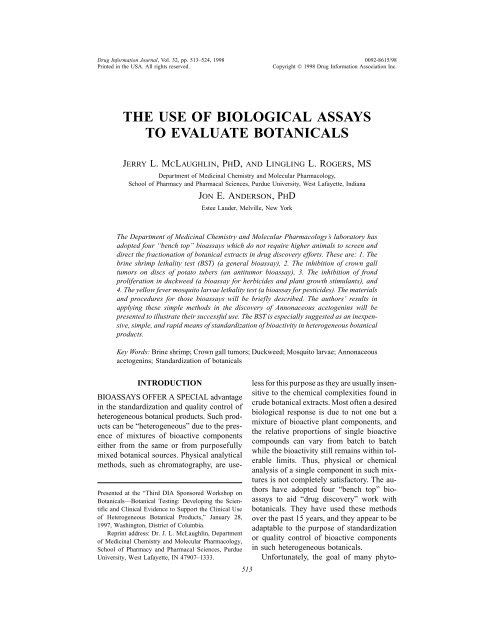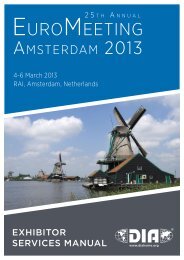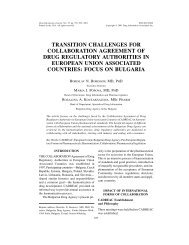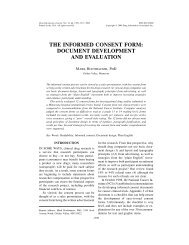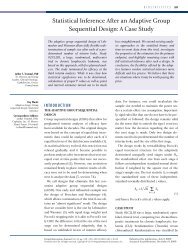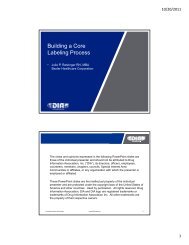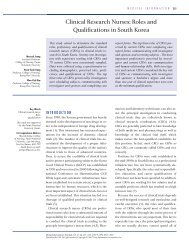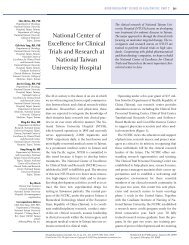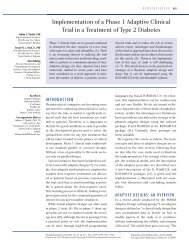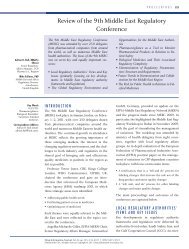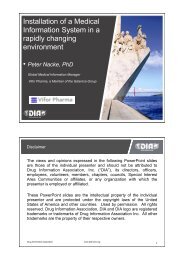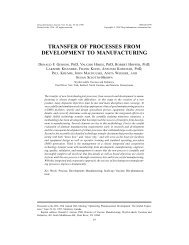the use of biological assays to evaluate botanicals - Drug ...
the use of biological assays to evaluate botanicals - Drug ...
the use of biological assays to evaluate botanicals - Drug ...
You also want an ePaper? Increase the reach of your titles
YUMPU automatically turns print PDFs into web optimized ePapers that Google loves.
<strong>Drug</strong> Information Journal, Vol. 32, pp. 513–524, 1998 0092-8615/98<br />
Printed in <strong>the</strong> USA. All rights reserved. Copyright © 1998 <strong>Drug</strong> Information Association Inc.<br />
THE USE OF BIOLOGICAL ASSAYS<br />
TO EVALUATE BOTANICALS<br />
JERRY L. MCLAUGHLIN, PHD, AND LINGLING L. ROGERS, MS<br />
Department <strong>of</strong> Medicinal Chemistry and Molecular Pharmacology,<br />
School <strong>of</strong> Pharmacy and Pharmacal Sciences, Purdue University, West Lafayette, Indiana<br />
JON E. ANDERSON, PHD<br />
Estee Lauder, Melville, New York<br />
The Department <strong>of</strong> Medicinal Chemistry and Molecular Pharmacology’s labora<strong>to</strong>ry has<br />
adopted four “bench <strong>to</strong>p” bio<strong>assays</strong> which do not require higher animals <strong>to</strong> screen and<br />
direct <strong>the</strong> fractionation <strong>of</strong> botanical extracts in drug discovery efforts. These are: 1. The<br />
brine shrimp lethality test (BST) (a general bioassay), 2. The inhibition <strong>of</strong> crown gall<br />
tumors on discs <strong>of</strong> pota<strong>to</strong> tubers (an antitumor bioassay), 3. The inhibition <strong>of</strong> frond<br />
proliferation in duckweed (a bioassay for herbicides and plant growth stimulants), and<br />
4. The yellow fever mosqui<strong>to</strong> larvae lethality test (a bioassay for pesticides). The materials<br />
and procedures for those bio<strong>assays</strong> will be briefly described. The authors’ results in<br />
applying <strong>the</strong>se simple methods in <strong>the</strong> discovery <strong>of</strong> Annonaceous ace<strong>to</strong>genins will be<br />
presented <strong>to</strong> illustrate <strong>the</strong>ir successful <strong>use</strong>. The BST is especially suggested as an inexpensive,<br />
simple, and rapid means <strong>of</strong> standardization <strong>of</strong> bioactivity in heterogeneous botanical<br />
products.<br />
Key Words: Brine shrimp; Crown gall tumors; Duckweed; Mosqui<strong>to</strong> larvae; Annonaceous<br />
ace<strong>to</strong>genins; Standardization <strong>of</strong> <strong>botanicals</strong><br />
INTRODUCTION less for this purpose as <strong>the</strong>y are usually insen-<br />
BIOASSAYS OFFER A SPECIAL advantage<br />
in <strong>the</strong> standardization and quality control <strong>of</strong><br />
heterogeneous botanical products. Such products<br />
can be “heterogeneous” due <strong>to</strong> <strong>the</strong> pres-<br />
ence <strong>of</strong> mixtures <strong>of</strong> bioactive components<br />
ei<strong>the</strong>r from <strong>the</strong> same or from purposefully<br />
mixed botanical sources. Physical analytical<br />
methods, such as chroma<strong>to</strong>graphy, are <strong>use</strong>sitive<br />
<strong>to</strong> <strong>the</strong> chemical complexities found in<br />
crude botanical extracts. Most <strong>of</strong>ten a desired<br />
<strong>biological</strong> response is due <strong>to</strong> not one but a<br />
mixture <strong>of</strong> bioactive plant components, and<br />
<strong>the</strong> relative proportions <strong>of</strong> single bioactive<br />
compounds can vary from batch <strong>to</strong> batch<br />
while <strong>the</strong> bioactivity still remains within <strong>to</strong>l-<br />
erable limits. Thus, physical or chemical<br />
analysis <strong>of</strong> a single component in such mixtures<br />
is not completely satisfac<strong>to</strong>ry. The au-<br />
Presented at <strong>the</strong> “Third DIA Sponsored Workshop on<br />
Botanicals—Botanical Testing: Developing <strong>the</strong> Scienthors<br />
have adopted four “bench <strong>to</strong>p” bio<strong>assays</strong><br />
<strong>to</strong> aid “drug discovery” work with<br />
tific and Clinical Evidence <strong>to</strong> Support <strong>the</strong> Clinical Use <strong>botanicals</strong>. They have <strong>use</strong>d <strong>the</strong>se methods<br />
<strong>of</strong> Heterogeneous Botanical Products,” January 28, over <strong>the</strong> past 15 years, and <strong>the</strong>y appear <strong>to</strong> be<br />
1997, Washing<strong>to</strong>n, District <strong>of</strong> Columbia.<br />
Reprint address: Dr. J. L. McLaughlin, Department<br />
<strong>of</strong> Medicinal Chemistry and Molecular Pharmacology,<br />
School <strong>of</strong> Pharmacy and Pharmacal Sciences, Purdue<br />
adaptable <strong>to</strong> <strong>the</strong> purpose <strong>of</strong> standardization<br />
or quality control <strong>of</strong> bioactive components<br />
in such heterogeneous <strong>botanicals</strong>.<br />
University, West Lafayette, IN 47907–1333. Unfortunately, <strong>the</strong> goal <strong>of</strong> many phy<strong>to</strong>-<br />
513
514 Jerry L. McLaughlin, Lingling L. Rogers, and Jon E. Anderson<br />
chemists has been simply <strong>to</strong> isolate, charac- include diverse and unknown mechanisms as<br />
terize, and publish a plethora <strong>of</strong> novel botani- well as new chemical entities. In addition, in<br />
cally-derived chemical substances without such specific bio<strong>assays</strong> <strong>the</strong> same extracts<br />
regard <strong>to</strong> bioactivities. To achieve applied have <strong>to</strong> be analyzed many times, over and<br />
meaning and significance, <strong>to</strong>day’s work in over again, before detecting activities. It<br />
natural product chemistry must incorporate would seem more logical <strong>to</strong> prescreen with<br />
bio<strong>assays</strong>. Extracts must be screened for bio- general bio<strong>assays</strong>, throw out <strong>the</strong> negatives,<br />
logical activity, <strong>the</strong> “active” extracts selected, and <strong>the</strong>n employ specific bio<strong>assays</strong> on <strong>the</strong><br />
fractionations directed with bio<strong>assays</strong>, and actives. Unfortunately, this is not <strong>the</strong> trend<br />
<strong>the</strong> bioactive compounds identified and <strong>the</strong>n <strong>to</strong>day within <strong>the</strong> major pharmaceutical com-<br />
exploited. panies. The molecular pharmacologists have<br />
This is <strong>the</strong> salvation <strong>of</strong> <strong>the</strong> natural product assured <strong>the</strong>mselves <strong>of</strong> continued employchemist,<br />
and such work must be performed ment as each new specific bioassay that <strong>the</strong>y<br />
with all <strong>use</strong>ful bioactive <strong>botanicals</strong> if <strong>the</strong>se devise must be employed <strong>to</strong> retest <strong>the</strong>ir firm’s<br />
products are <strong>to</strong> be accepted and incorporated entire library <strong>of</strong> substances. Irrespective <strong>of</strong><br />
in<strong>to</strong> legitimate, long-term, health practices. whe<strong>the</strong>r general or specific bio<strong>assays</strong> are fa-<br />
Three readily available technologies must be vored, <strong>the</strong> <strong>use</strong> <strong>of</strong> all bio<strong>assays</strong> must be pro-<br />
combined:<br />
moted, and this promotion is <strong>the</strong> purpose<br />
<strong>of</strong> this paper. The four bio<strong>assays</strong> which are<br />
1. Separation techniques (chroma<strong>to</strong>graphy), described below are easily adapted as “bench<br />
2. Structural elucidation methods (spectrom- <strong>to</strong>p” procedures for <strong>use</strong> in natural product<br />
eters and X-ray crystallography), and chemistry. They are inexpensive, rapid, and<br />
3. Simple bio<strong>assays</strong>.<br />
Today’s natural product chemists are very<br />
technologically simple, requiring little technical<br />
training.<br />
familiar with <strong>the</strong> first two, but, generally,<br />
<strong>the</strong>y ignore <strong>the</strong> third. It is <strong>the</strong> hope <strong>of</strong> <strong>the</strong><br />
authors <strong>of</strong> this paper that talents can cease<br />
being wasted on <strong>the</strong> myriad <strong>of</strong> inactive natu-<br />
Brine Shrimp Lethality:<br />
A Rapid General Bioassay<br />
for Bioactive Compounds<br />
ral metabolites and can become increasingly Bioactive compounds are almost always<br />
devoted <strong>to</strong> <strong>the</strong> identification <strong>of</strong> bioactive bo- <strong>to</strong>xic in high doses. Pharmacology is simply<br />
tanical products. The health <strong>use</strong> <strong>of</strong> heteroge- <strong>to</strong>xicology at a lower dose, and <strong>to</strong>xicology<br />
neous standardized botanical products will is simply pharmacology at a higher dose.<br />
become generally acceptable in <strong>the</strong> United Thus, in vivo lethality in a simple zoologic<br />
States only after <strong>the</strong>ir bioactive components organism can be <strong>use</strong>d as a convenient monihave<br />
been identified. Standardization <strong>of</strong> <strong>the</strong> <strong>to</strong>r for screening and fractionation in <strong>the</strong> dis-<br />
products by <strong>biological</strong> <strong>assays</strong> will <strong>the</strong>n gencovery and moni<strong>to</strong>ring <strong>of</strong> bioactive natural<br />
erate reproducible benefits and <strong>the</strong> resulting products. The eggs <strong>of</strong> brine shrimp, Artemia<br />
consumer confidence.<br />
salina (Leach), are readily available in pet<br />
A rush <strong>to</strong> very specific, in vitro, robotic, shops at low cost and remain viable for years<br />
mechanism-based bio<strong>assays</strong> has occurred in in <strong>the</strong> dry state. Upon being placed in sea<br />
recent years. Recep<strong>to</strong>r binding, enzyme in- water, <strong>the</strong> eggs hatch within 48 hours <strong>to</strong> pro-<br />
hibition, affinity columns, DNA nicking, tuvide large numbers <strong>of</strong> larvae (nauplii) for<br />
bulin inhibition, and so forth usually mimic experimental <strong>use</strong>.<br />
<strong>the</strong> effects <strong>of</strong> some previously known com- Brine shrimp nauplii have been <strong>use</strong>d prepound<br />
having a specific mechanism <strong>of</strong> ac- viously in a number <strong>of</strong> bioassay systems, but<br />
tion. Researchers must be cautious, however, <strong>the</strong> authors have developed a method where-<br />
with mechanism-based <strong>assays</strong>. The field <strong>of</strong> by natural product extracts, fractions, or pure<br />
vision <strong>of</strong> such specific microscopes is very compounds are tested at initial concentra-<br />
narrow; <strong>the</strong>y must be assured that <strong>the</strong> scope tions <strong>of</strong> 10, 100, and 1000 ppm (or mcg/<br />
<strong>of</strong> <strong>the</strong>ir bio<strong>assays</strong> can be wide enough <strong>to</strong><br />
ml) in vials containing 5 ml <strong>of</strong> brine and
Biological Assays <strong>to</strong> Evaluate Botanicals 515<br />
10 shrimp in each <strong>of</strong> three replicates (1,2). tive bacterium, Agrobacterium tumefaciens<br />
Survivors are counted after 24 hours. These (Smith and Townsend) Conn. The bacteria<br />
data are processed in a simple program for contain large Ti (tumor-inducing) plasmids<br />
probit analysis on a personal computer <strong>to</strong> which carry genetic information (T-DNA)<br />
estimate LC50 values with 95% confidence that transforms normal, wounded, plant cells<br />
intervals for statistically significant compari- in<strong>to</strong> au<strong>to</strong>nomous tumor cells. In 1980, Galsons<br />
<strong>of</strong> potencies. The authors initially found sky et al. (5,6) at Bradley University demona<br />
positive correlation between brine shrimp strated that <strong>the</strong> inhibition <strong>of</strong> crown gall tu-<br />
<strong>to</strong>xicity and 9KB (human nasopharyngeal car- mors on discs <strong>of</strong> pota<strong>to</strong> (Solanum tuberosum<br />
cinoma) cy<strong>to</strong><strong>to</strong>xicity (p = 0.036 and kappa = L.) tubers showed an apparent correlation<br />
0.56), and now <strong>use</strong> <strong>the</strong> brine shrimp test as with compounds and plant extracts known <strong>to</strong><br />
a prescreen for a panel <strong>of</strong> six human solid be active in <strong>the</strong> 3PS (in vivo, murine leuke-<br />
tumor cell lines at <strong>the</strong> Cell Culture Labora- mia) antitumor assay. In preliminary studies<br />
<strong>to</strong>ry <strong>of</strong> <strong>the</strong> Purdue Cancer Center. The au- in 1980–1983 at Purdue, <strong>the</strong> authors modithors<br />
have observed that ED50 values for cy- fied <strong>the</strong> Galsky pota<strong>to</strong> disc method and tested<br />
<strong>to</strong><strong>to</strong>xicities are generally about one-tenth <strong>the</strong> <strong>the</strong> effectiveness, with appropriate statistical<br />
LC50 values found in <strong>the</strong> brine shrimp test. evaluation, <strong>of</strong> <strong>the</strong> modified assay as a pre-<br />
Over 300 novel antitumor and pesticidal natscreen for 3PS activity in crude plant exural<br />
products have now been isolated in <strong>the</strong> tracts. The modified assay was initially per-<br />
labora<strong>to</strong>ry at Purdue University using this formed on a series <strong>of</strong> natural antitumor<br />
bioassay as <strong>the</strong> prescreen (2,3,4). compounds, on plant extracts suspected <strong>to</strong><br />
Thus, it is possible <strong>to</strong> detect and <strong>the</strong>n mon- have 3PS activity, and on ethanol and hexane<br />
i<strong>to</strong>r <strong>the</strong> fractionation <strong>of</strong> cy<strong>to</strong><strong>to</strong>xic, as well as extracts <strong>of</strong> seeds <strong>of</strong> 41 Euphoriaceae species<br />
3PS (P388) (in vivo murine leukemia) active (7); inhibition <strong>of</strong> 20% or more <strong>of</strong> <strong>the</strong> tumors<br />
extracts using <strong>the</strong> brine shrimp lethality bio- is considered significant.<br />
assay ra<strong>the</strong>r than more tedious and expensive<br />
in vitro and in vivo antitumor <strong>assays</strong>. The<br />
Statistical relationships were assessed by:<br />
brine shrimp assay has advantages <strong>of</strong> being 1. Four-fold tables,<br />
rapid (24 hours), inexpensive, and simple 2. The Fisher-Irwin test for significance <strong>of</strong><br />
(eg, no aseptic techniques are required). It association, and<br />
easily utilizes a large number <strong>of</strong> organisms 3. Calculation <strong>of</strong> Kappa values <strong>to</strong> indicate<br />
for statistical validation and requires no special<br />
equipment and a relatively small amount<br />
<strong>the</strong> degree <strong>of</strong> data agreement.<br />
<strong>of</strong> sample (2–20 mg or less). Fur<strong>the</strong>rmore, Surprisingly, <strong>the</strong> plant screening results <strong>of</strong><br />
it does not require animal serum as is needed <strong>the</strong> pota<strong>to</strong> disc assay were very strongly asso-<br />
for cy<strong>to</strong><strong>to</strong>xicities. Animal rights advocates ciated with <strong>the</strong> 3PS results (p = 0.002), while<br />
have not yet objected <strong>to</strong> <strong>the</strong> <strong>use</strong> <strong>of</strong> <strong>the</strong>se cy<strong>to</strong><strong>to</strong>xicity <strong>assays</strong>, 9PS (p = 0.114) and 9KB<br />
invertebrates in experimental work. In <strong>the</strong> (p = 0.140), were much less reliable as pre-<br />
authors’ labora<strong>to</strong>ries, each researcher condic<strong>to</strong>rs <strong>of</strong> 3PS activity. The calculated Kappa<br />
ducts his/her own brine shrimp bio<strong>assays</strong> on values for pota<strong>to</strong> disc, 9PS, and 9KB were<br />
his/her own bench. Self-reliance and rapid 0.64, 0.24, and 0.45, respectively. Kappa<br />
results are important advantages in this type values greater <strong>the</strong>n 0.75 represent excellent<br />
<strong>of</strong> work. Table 1 and Figure 1 summarize <strong>the</strong> agreement beyond chance; values less <strong>the</strong>n<br />
materials and procedures. 0.40 represent poor agreement; and values<br />
between 0.40 and 0.75 represent fair <strong>to</strong> good<br />
Crown Gall Tumors on Pota<strong>to</strong> Discs:<br />
An Animal-Sparing Bioassay for<br />
Antitumor Compounds<br />
agreement. The combined results showed an<br />
even better correlation between <strong>the</strong> in vivo<br />
3PS results and <strong>the</strong> pota<strong>to</strong> disc method (p =<br />
2 × 10 −6 ).<br />
Crown gall is a neoplastic disease <strong>of</strong> plants The authors concluded that, with <strong>the</strong>se<br />
induced by specific strains <strong>of</strong> <strong>the</strong> Gram nega- modified procedures (Table 2), crown gall
516 Jerry L. McLaughlin, Lingling L. Rogers, and Jon E. Anderson<br />
TABLE 1<br />
Materials and Procedures for Brine Shrimp Lethality Bioassay<br />
MATERIALS<br />
1. Artemia salina cysts (brine shrimp eggs from s<strong>to</strong>re). Most pet shops carry <strong>the</strong>se as a<br />
type <strong>of</strong> fish food.<br />
2. Sea salt (also from fish s<strong>to</strong>re).<br />
3. Small tank (hatching chamber) <strong>to</strong> grow shrimp with dividing dam, cover, and lamp <strong>to</strong> attract<br />
shrimp (The hatching chamber can be conveniently made from a covered plastic<br />
soap dish).<br />
4. Syringes: 5 ml, 0.5 ml, 100 mcl, and 10 mcl (smaller syringes are not needed if dilutions<br />
are prepared in <strong>the</strong> alternative dilution procedure as described in Figure 1).<br />
5. Two dram vials (9 per sample + 1 control).<br />
PROCEDURES<br />
1. Prepare sea water according <strong>to</strong> directions on box (38 g sea salt per liter <strong>of</strong> water), filter.<br />
2. Put sea water in small tank, add shrimp eggs <strong>to</strong> one side <strong>of</strong> <strong>the</strong> divided tank, and cover<br />
this side. The lamp above <strong>the</strong> o<strong>the</strong>r side will attract <strong>the</strong> hatched shrimp.<br />
3. Allow two days for <strong>the</strong> shrimp <strong>to</strong> hatch and mature as nauplii (in warmer climates, hatching<br />
may take place sooner, but <strong>the</strong> authors <strong>use</strong> 48–72 hr nauplii <strong>to</strong> be consistent).<br />
4. Prepare vials for testing; for each fraction, test initially at 1000, 100, and 10 mcg/ml; prepare<br />
three vials at each concentration for a <strong>to</strong>tal <strong>of</strong> nine vials; weigh 20 mg <strong>of</strong> sample<br />
and add 2 ml <strong>of</strong> solvent (20 mg/2 ml); from this solution transfer 500, 50, or 5 mcl <strong>to</strong> vials<br />
corresponding <strong>to</strong> 1000, 100, or 10 mcg/ml, respectively. Evaporate solvent under nitrogen<br />
and <strong>the</strong>n put under high vacuum for about 30 min.; volatile solvents will evaporate<br />
over night. Alternatively, materials may be dissolved in DMSO (dimethylsulfoxide), and up<br />
<strong>to</strong> 50 mcl may be added per 5 ml <strong>of</strong> brine before DMSO <strong>to</strong>xicity will affect <strong>the</strong> results. An<br />
alternative dilution procedure is illustrated in Figure 1; this procedure avoids <strong>the</strong> need for<br />
<strong>the</strong> expensive 100 mcl and 10 mcl syringes.<br />
5. After two days (when <strong>the</strong> shrimp larvae are ready), add about 4 ml <strong>of</strong> sea water <strong>to</strong> each<br />
vial, count 10 shrimp per vial (30 shrimp per dilution), and adjust <strong>the</strong> volume with sea water<br />
<strong>to</strong> 5 ml/vial. Place <strong>the</strong> vials, uncovered, under <strong>the</strong> lamp. Be sure that vials are not<br />
overheated by <strong>the</strong> lamp.<br />
6. Twenty-four hours later count and record <strong>the</strong> number <strong>of</strong> survivors.<br />
7. Analyze <strong>the</strong> data with <strong>the</strong> Finney computer program for probit analysis <strong>to</strong> determine LC 50<br />
values and 95% confidence intervals. A copy <strong>of</strong> this program for IBM PCs is available<br />
from Dr. McLaughlin; a $10.00 donation is requested <strong>to</strong> cover costs, postage, and handling.<br />
8. Additional dilutions at less than 10 mcg/ml may be needed <strong>to</strong> determine <strong>the</strong> LC 50 values<br />
for potent materials; also, intermediate concentrations, eg, at 750, 500, and 250 mcg/ml<br />
can be prepared and tested <strong>to</strong> narrow <strong>the</strong> confidence intervals. By starting with 2 mg/ml<br />
(step 4 above) dilutions at 100, 10, and 1 mcg/ml are easily prepared for more potent materials.<br />
tumors on pota<strong>to</strong> discs could routinely be bioassay has, itself, fallen in<strong>to</strong> disfavor as<br />
employed as a comparatively rapid, inexpen- being <strong>to</strong>o predictive <strong>of</strong> “s<strong>of</strong>t” versus “solid”<br />
sive, safe, animal-sparing, and statistically<br />
reliable prescreen for in vivo 3PS antitumor<br />
antitumor compounds.<br />
activity. The methodology is simple, and, although<br />
aseptic technique is required, <strong>the</strong> bioassay<br />
can be performed in ho<strong>use</strong> with mini-<br />
mal technical training. The authors have since<br />
Frond Inhibition <strong>of</strong> Lemna (duckweed):<br />
A Bioassay for Plant Growth Stimulants<br />
and Inhibi<strong>to</strong>rs<br />
<strong>use</strong>d this assay <strong>to</strong> detect and isolate several Lemna minor L. (duckweed) is a miniature<br />
dozen novel, antitumor compounds from var- aquatic monocot. Lemna plants consist <strong>of</strong> a<br />
ious plant species (2,3,4), and it continues central oval frond or mo<strong>the</strong>r frond with two<br />
<strong>to</strong> predict, effectively and reliably, in vivo attached daughter fronds and a filamentious<br />
animal antitumor activity although <strong>the</strong> 3PS root. Under normal conditions, <strong>the</strong> plants re-
Biological Assays <strong>to</strong> Evaluate Botanicals 517<br />
FIGURE 1. Flow chart for alternate dilution procedure for brine shrimp bioassay.<br />
produce exponentially with buddings <strong>of</strong> proliferation) or FP50 values (concentrations<br />
daughter fronds from pouches on <strong>the</strong> sides causing 50% increase in proliferation <strong>of</strong><br />
<strong>of</strong> <strong>the</strong> mo<strong>the</strong>r fronds. A previous report by fronds) are determined using <strong>the</strong> Finney pro-<br />
Einhellig et al. (8) provided general guidegram on an IBM personal computer; 95%<br />
lines for developing a Lemna bioassay <strong>to</strong> confidence intervals are also determined <strong>to</strong><br />
screen a large number <strong>of</strong> plant extracts and provide statistical relevance.<br />
chemical substances for <strong>the</strong>ir effects on plant The search for biodegradable herbicides<br />
growth.<br />
may be extended <strong>to</strong> include natural com-<br />
Single Lemna plants, consisting <strong>of</strong> three pounds (allelochemicals), and this is a simple<br />
fronds (1 mo<strong>the</strong>r and 2 daughter fronds), are screen for such activity. In addition, <strong>the</strong> au-<br />
placed in<strong>to</strong> two dram vials containing 2 ml thors find that some natural substances stim-<br />
<strong>of</strong> a special medium (E medium). By evapoulate frond proliferation, and <strong>the</strong> assay may<br />
ration <strong>of</strong> volatile solvents, appropriate dilu- be <strong>use</strong>ful <strong>to</strong> detect new plant growth stimu-<br />
tions <strong>of</strong> test substances have been previously lants. Usnic acid was shown <strong>to</strong> be a potent<br />
evaporated in <strong>the</strong> vials <strong>to</strong> deliver initial con- herbicide (FI50 = 0.91 ppm). Hippuric acid<br />
centrations <strong>of</strong> 500, 50, and 5 ppm in <strong>the</strong> was shown <strong>to</strong> be a potent (FP50 = 125 ppm)<br />
medium. The vials are placed in translucent, plant growth stimulant; this unexpected ac-<br />
glass-covered dishes, <strong>to</strong> avoid moisture loss, tivity <strong>of</strong> this common urinary constituent had<br />
and placed in a plant growth chamber at 27– never before been documented. The commer-<br />
29°C with 24 hours <strong>of</strong> fluorescent and incancial need for such natural, biodegradable,<br />
descent light. After seven days <strong>the</strong> number herbicides and plant growth stimulants may<br />
<strong>of</strong> fronds are counted, and FI50 values (con- someday be filled with natural products decentrations<br />
necessary <strong>to</strong> inhibit 50% <strong>of</strong> frond tected by this simple and convenient Lemna
518 Jerry L. McLaughlin, Lingling L. Rogers, and Jon E. Anderson<br />
TABLE 2<br />
The Pota<strong>to</strong> Disc Bioassay Modified for Plant Extracts and Compounds<br />
MATERIALS<br />
A. Preparation <strong>of</strong> Agrobacterium tumefaciens (two days before assay): Prepare growth medium<br />
by adding 0.5 g sucrose, 0.8 g nutrient broth (Difco), and 0.1 g yeast extract (Difco)<br />
<strong>to</strong> 100 ml <strong>of</strong> water in a 250 ml flask. Plug <strong>the</strong> flask with cot<strong>to</strong>n, cover with aluminum foil,<br />
and sterilize in an au<strong>to</strong>clave for 12 minutes. Allow <strong>the</strong> medium <strong>to</strong> cool and add 1 loop <strong>of</strong><br />
Agrobacterium tumefaciens, from a s<strong>to</strong>rage culture on an agar slant, using sterile technique.<br />
Place <strong>the</strong> flask on a shaker for 48 hours below 30°C.<br />
B. Items <strong>to</strong> prepare for experiment:<br />
1. strips <strong>of</strong> parafilm<br />
2. Four (4) mg <strong>of</strong> sample in a 2 dram (10 ml) vial<br />
3. 1.5 g bac<strong>to</strong>-agar (Difco) for each sample including control<br />
4. Cover with aluminum foil: tweezers, cutter, 1.8 mm cork borer (size 13), and tray<br />
5. One (1) tube rack with 1 screw cap culture tube per sample including control<br />
6. For each sample, 1 screw cap culture tube containing 2 ml distilled water<br />
7. Red-skinned pota<strong>to</strong>es (Solanum tuberosum) and bleach (Chlorox TM )<br />
8. Ethanol for disinfection<br />
9. Three (3) Petri dishes per sample and three (3) for <strong>the</strong> control<br />
PROCEDURES<br />
1. Prepare 1.5% agar by adding 100 ml water per sample <strong>to</strong> step B.3<br />
2. Sterilize by au<strong>to</strong>clave all things in steps B. 3–6 for 15 minutes<br />
3. Wash pota<strong>to</strong>es with water and soak in bleach<br />
4. Clean laminar flow hood with ethanol<br />
5. Pour 20 ml sterilized agar solution per Petri dish and let cool<br />
6. Dissolve 4 mg sample in 1 ml DMSO<br />
7. Use 1 ml <strong>of</strong> DMSO as blank standard<br />
8. Preparation <strong>of</strong> inocculum<br />
a. add 1.5 ml water, 2.0 ml <strong>of</strong> <strong>the</strong> 48 hr bacterial culture, and 0.5 ml sample in<br />
DMSO <strong>to</strong> tube<br />
b. prepare control by replacing sample with 0.5 ml DMSO<br />
c. <strong>use</strong> sterile technique (flame and cap).<br />
9. Take pota<strong>to</strong> out <strong>of</strong> bleach, cut away ends, and bore out cylinders on<strong>to</strong> <strong>the</strong> sterile tray<br />
10. Cut cylinders in<strong>to</strong> discs and place 5 discs per Petri dish by gently pushing <strong>the</strong> discs<br />
in<strong>to</strong> <strong>the</strong> agar using aseptic technique<br />
11. Prepare at least 3 Petri dishes per sample and control<br />
12. Add one drop (0.05 ml) <strong>of</strong> <strong>the</strong> prepared innoculum per disc<br />
13. Seal <strong>the</strong> edge <strong>of</strong> each Petri dish with parafilm strips <strong>to</strong> prevent moisture loss during<br />
<strong>the</strong> incubation period; keep <strong>the</strong> dish level at all times <strong>to</strong> keep <strong>the</strong> innoculum on <strong>the</strong><br />
<strong>to</strong>ps <strong>of</strong> <strong>the</strong> discs<br />
14. Keep in <strong>the</strong> dark at 27°C and count <strong>the</strong> tumors after 12 <strong>to</strong> 21 days<br />
15. Calculate <strong>the</strong> percent inhibition <strong>of</strong> crown gall tumors as follows:<br />
% inhibition = 100 −<br />
Average number tumors <strong>of</strong> sample<br />
× 100<br />
Average number tumors <strong>of</strong> control<br />
bioassay. The materials and procedures are <strong>to</strong>p” bioassay that can be <strong>use</strong>d <strong>to</strong> determine<br />
listed in Table 3.<br />
<strong>the</strong> pesticidal activities <strong>of</strong> botanical extracts,<br />
fractions, and isolated compounds. The eggs<br />
Yellow Fever Mosqui<strong>to</strong> (YFM) Test:<br />
A Bioassay for Pesticides<br />
<strong>of</strong> <strong>the</strong> yellow fever mosqui<strong>to</strong>es, Aedes<br />
aegypti (Linnaeus), are obtained from Dr.<br />
Steven Sackett, <strong>of</strong> <strong>the</strong> New Orleans Mosqui<strong>to</strong><br />
The yellow fever mosqui<strong>to</strong> larvae microtiter Control Board, and are s<strong>to</strong>red at room template<br />
assay (YFM) (9) is a simple “bench perature in a sealed container. Ano<strong>the</strong>r small
Biological Assays <strong>to</strong> Evaluate Botanicals 519<br />
TABLE 3<br />
The Lemna Bioassay Modified for Plant Extracts and Compounds (8)<br />
MATERIALS<br />
1. Lemna minor prepared by aseptic technique described below, if contaminated<br />
2. E Medium (about 80 ml per compound)<br />
3. Syringes: 10 μl, 100 μl,1ml,2ml<br />
4. 2 dram vials (40 per compound)<br />
5. Large glass container <strong>to</strong> hold vials; translucent plate glass <strong>to</strong> form a lid; s<strong>to</strong>pcock grease<br />
<strong>to</strong> form a seal <strong>to</strong> avoid moisture loss<br />
6. Growth chamber with temperature range <strong>of</strong> 27 <strong>to</strong> 29°C and 24 hours <strong>of</strong> fluorescent and<br />
incandescent lights<br />
PROCEDURES<br />
1. Prepare inorganic medium E (see below); add KOH pellets <strong>to</strong> pH 5.5–6.0<br />
2. Prepare vials for testing: 10 vials per dose (500, 50, 5 ppm, control)<br />
a. Weigh 15 mg <strong>of</strong> compound and dissolve in 15 ml solvent<br />
b. Add 1000, 100, and 10 μl solution <strong>to</strong> vials for 500, 50 and 5 ppm. Allow solvent <strong>to</strong><br />
evaporate overnight<br />
c. Add 2 ml <strong>of</strong> E Medium and <strong>the</strong>n a single plant containing a rosette <strong>of</strong> three fronds <strong>to</strong><br />
each vial<br />
3. Place vials in glass dish filled with about 2 cm water, seal container with s<strong>to</strong>pcock grease<br />
and glass plate<br />
4. Place dish with vials in growth chamber for seven days<br />
5. Count and record number <strong>of</strong> fronds per vial on days 3 and 7<br />
6. Analyze data as percent <strong>of</strong> control with ED50 computer-program (available from Dr.<br />
McLaughlin) <strong>to</strong> determine FI50 and FP50 values and 95% confidence intervals<br />
500 ppm = 15 mg compound/15 ml solvent × 1000 ml solution/2 ml E Medium<br />
50 ppm = 15 mg compound/15 ml solvent × 100 ml solution/2 ml E Medium<br />
5 ppm = 15 mg compound/15 ml solvent × 10 ml solution/2 ml E Medium<br />
E MEDIUM<br />
mg/L<br />
KH2PO4 680<br />
KNO3 1515<br />
Ca(NO3) 24H2O 1180<br />
MgSO47H2O 492<br />
H 3BO 3<br />
286<br />
MnCl 24H 2O 3.62<br />
FeCl 36H 2O 5.40<br />
ZnSO 47H 2O 0.22<br />
CuSO 45H 2O 0.22<br />
Na 2MoO 42H 2O 0.12<br />
EDTA 11.2<br />
open jar with saturated zinc sulfate solution incubation with test material, <strong>the</strong> surviving<br />
can be put in <strong>the</strong> container <strong>to</strong> maintain a larvae are counted, and <strong>the</strong> data can be pro-<br />
relative humidity between 80–90%. cessed in <strong>the</strong> simple probit analysis program<br />
After being hatched in warm water over- on a personal computer <strong>to</strong> estimate LC50 valnight,<br />
<strong>the</strong> larvae are allowed <strong>to</strong> develop in ues with 95% confidence intervals for statis-<br />
bovine liver powder solution for four days. tically significant comparisons <strong>of</strong> potencies.<br />
The surviving larvae are <strong>the</strong>n transferred <strong>to</strong> The amounts <strong>of</strong> samples <strong>use</strong>d in this assay<br />
MES (2[N-morpholino] ethanesulfonic acid) are fairly small, 5–25 mg (corresponding <strong>to</strong><br />
buffer solution and <strong>use</strong>d for <strong>the</strong> tests. Natural testing concentrations <strong>of</strong> 1000 μg/ml <strong>to</strong> 5000<br />
product extracts, fractions, or pure com- μg/ml). Rotenone can be <strong>use</strong>d as a positive<br />
pounds are tested in five, 1 : 10, dilutions control for <strong>the</strong> assay. Pure substances with<br />
starting at 5000 μg/ml. After four days <strong>of</strong><br />
LC50 values ≤1.0 μg/ml are worthy <strong>of</strong> com
520 Jerry L. McLaughlin, Lingling L. Rogers, and Jon E. Anderson<br />
mercial development. Table 4 summarizes double bonds. Recently, <strong>the</strong> authors have<br />
<strong>the</strong> materials and procedures.<br />
found ace<strong>to</strong>genins bearing tetrahydropyran<br />
(THP) rings (14). Biologically, <strong>the</strong>se com-<br />
VALIDATION AND THE<br />
ANNONACEOUS ACETOGENINS<br />
pounds are among <strong>the</strong> most potent <strong>of</strong> <strong>the</strong><br />
known inhibi<strong>to</strong>rs <strong>of</strong> complex I (NADH : ubiquinone<br />
oxidoreductase) in mi<strong>to</strong>chondrial<br />
The first three simple “bench <strong>to</strong>p” bio<strong>assays</strong>, electron transport systems and <strong>of</strong> <strong>the</strong> plasma<br />
as well as cy<strong>to</strong><strong>to</strong>xicities in three human solid membrane NADH : oxidase that is character-<br />
tumor cell lines, were compared for accuraistic <strong>of</strong> cancerous cells; <strong>the</strong>se actions seem<br />
cies <strong>to</strong> detect known-3PS in vivo (P-388) ac- <strong>to</strong> induce apop<strong>to</strong>sis (programmed cell death),<br />
tive antitumor agents supplied blind by Dr. perhaps as a consequence <strong>of</strong> ATP depriva-<br />
Mat<strong>the</strong>w Suffness <strong>of</strong> <strong>the</strong> United States Na- tion. Applications as pesticides and antitumor<br />
tional Cancer Institute. The pota<strong>to</strong> disc assay agents hold excellent potential, especially in<br />
was <strong>the</strong> best predic<strong>to</strong>r and showed excellent <strong>the</strong> thwarting <strong>of</strong> resistance mechanisms which<br />
correlation <strong>to</strong> in vivo activities (p = 0.008). require an ATP-dependent efflux (15,16,17).<br />
The brine shrimp bioassay (p = 0.033) proved The authors’ labora<strong>to</strong>ry has published four<br />
<strong>to</strong> be superior or equally as accurate as <strong>the</strong> comprehensive reviews on <strong>the</strong> Annonaceous<br />
three in vitro human solid tumor cell lines ace<strong>to</strong>genins (18–21), and this work has been<br />
(p = 0.033–0.0334); it gave no false positives guided by <strong>the</strong> above bio<strong>assays</strong> <strong>to</strong> yield over<br />
and only one false negative; as expected, <strong>the</strong> 180 <strong>of</strong> <strong>the</strong>se potent compounds. Structure-<br />
Lemna assay showed <strong>the</strong> poorest correlation activity relationship studies, using <strong>the</strong>se, in-<br />
(p = 0.708) with 3PS; however, it detected cluding <strong>the</strong> YFM test and o<strong>the</strong>r bio<strong>assays</strong>,<br />
plant growth stimulation as well as inhibition permit prediction <strong>of</strong> <strong>the</strong> optimum structures<br />
effects among <strong>the</strong> several test substances (10). for antitumor and pesticidal effects (22,23,<br />
The authors now suggest <strong>the</strong> brine shrimp 24). Asimicin (1) and bullatacin (2) (Figure<br />
and pota<strong>to</strong> disc bio<strong>assays</strong> as convenient in- 2) are two <strong>of</strong> <strong>the</strong> most potent compounds in<br />
ho<strong>use</strong> prescreens <strong>to</strong> <strong>the</strong> more expensive mech- this series and have been patented (25,26).<br />
anism-based, cy<strong>to</strong><strong>to</strong>xicity, or in vivo antitu- Two Annonaceous species, Asimina triloba<br />
mor <strong>assays</strong>. In addition, <strong>the</strong> brine shrimp test Dunal (“paw paw”) and Annona muricata L.<br />
is an effective screening method for pesti- (“sour sop,” “guanabana”), are, respectively,<br />
cides, as exemplified by <strong>the</strong> authors’ discov- abundant as fruit trees in temperate eastern<br />
ery <strong>of</strong> <strong>the</strong> Annonaceous ace<strong>to</strong>genins as a new North America and in <strong>the</strong> tropics worldwide.<br />
class <strong>of</strong> natural pesticides (11,12). These Both <strong>of</strong> <strong>the</strong>se species have now yielded a<br />
compounds are also powerful as in vivo ac- variety <strong>of</strong> new ace<strong>to</strong>genins, and <strong>the</strong>ir crude<br />
tive antitumor agents with bullatacin (2) (Fig- extracts exhibit potent pesticidal effects. These<br />
ure 2) showing 300 times <strong>the</strong> potency <strong>of</strong> taxol crude extracts can be employed as safe, effecagainst<br />
L1210 murine leukemia (13). tive, economical, and environmentally friend-<br />
Since <strong>the</strong>ir discovery in 1982, <strong>the</strong> Annon- ly pesticides with an emphasis on <strong>the</strong> home<br />
aceous ace<strong>to</strong>genins (named for <strong>the</strong> plant fam- garden, ornamental, greenho<strong>use</strong>, and produce<br />
ily, Annonaceae) have become one <strong>of</strong> <strong>the</strong> markets, pending regula<strong>to</strong>ry approval.<br />
most rapidly growing classes <strong>of</strong> bioactive The complexities <strong>of</strong> <strong>the</strong>se ace<strong>to</strong>genin mix-<br />
natural products. Chemically, <strong>the</strong>y are C-32 tures, undoubtedly, serve as a benefit in <strong>the</strong><br />
or C-34 long chain fatty acids which have protection <strong>of</strong> <strong>the</strong> trees against a host <strong>of</strong> mi-<br />
been combined with a 2-propanol unit at crobes, pests, and herbivores. It is known that<br />
C-2 <strong>to</strong> form a γ-lac<strong>to</strong>ne. Biogenetically, dou- such a series <strong>of</strong> structurally related secondary<br />
ble bonds along <strong>the</strong> fatty acid chain seem <strong>to</strong> plant products can even display a level <strong>of</strong><br />
epoxidize and cyclize <strong>to</strong> form one, two, or <strong>to</strong>xicity <strong>to</strong> pests that is lacking in <strong>the</strong> individ-<br />
three tetrahydr<strong>of</strong>uran (THF) rings, <strong>of</strong>ten with ual compounds (27). The recent work <strong>of</strong> Feng<br />
flanking hydroxyls; o<strong>the</strong>r functional groups and Isman (28) showed that, after 40 genera-<br />
include hydroxyls, ace<strong>to</strong>xyls, carbonyls, and tions, green peach aphids, which were repeat-
Biological Assays <strong>to</strong> Evaluate Botanicals 521<br />
TABLE 4<br />
Materials and Procedures for <strong>the</strong> Yellow Fever Mosqui<strong>to</strong> (YFM) Test<br />
MATERIALS<br />
1. Aedes aegypti (yellow fever mosqui<strong>to</strong>) eggs (from Dr. Steven Sackett <strong>of</strong> <strong>the</strong> New Orleans<br />
Mosqui<strong>to</strong> Control Board, New Orleans, LA 70126)<br />
2. MES (2-[N-morpholino] ethanesulfonic acid) (from Sigma)<br />
3. Bovine liver powder (from ICN Biochemicals)<br />
4. 96 U and F microwell plates and lids (from VWR Scientific)<br />
5. Syringes: 10 μl, 50 μl, 100 μl<br />
6. Pipette<br />
a. regular dispo-pipette<br />
b. a mo<strong>to</strong>rized microliter pipette with liquid ends (Rainin Instrument Company)<br />
c. a Vaccu-Pette/96 pipette (Vanguard International)<br />
7. Vials: 4 ml glass vials with septums (five for each sample tested)<br />
8. A glass vessel, a jar, or a 500 ml beaker for s<strong>to</strong>ring developed mosqui<strong>to</strong> larvae<br />
PROCEDURES<br />
1. Put YFM eggs in a small vial with 5–10 ml <strong>of</strong> warm water, let stand for 2–3 hours<br />
2. Transfer <strong>the</strong> above contents in<strong>to</strong> a jar or a beaker containing bovine liver powder solution<br />
at a concentration <strong>of</strong> �4 mg/ml<br />
3. Allow <strong>to</strong> develop for four days<br />
4. Harvest <strong>the</strong> live larvae with a pipette, transfer <strong>the</strong>m in<strong>to</strong> a jar or beaker which contains<br />
5 mM MES pH 6.5 solution<br />
5. Use a Vaccu-Pette/96 <strong>to</strong> fill 96-well microwell plate with 240 μl 5 mM MES solution per<br />
well<br />
6. Prepare solutions for testing: <strong>to</strong> start with a concentration <strong>of</strong> testing material <strong>of</strong> 5000 μl/<br />
ml, 25 mg <strong>of</strong> <strong>the</strong> test material is weighed and dissolved in 100 μl <strong>of</strong> methanol in a<br />
sealed vial; this testing solution (250 μl/ml) is <strong>the</strong>n injected in<strong>to</strong> eight wells on <strong>the</strong> microliter<br />
plate with 5 μl each. The final concentration <strong>of</strong> <strong>the</strong> testing material in <strong>the</strong>se eight<br />
wells will be 5000 μg/ml. Ano<strong>the</strong>r 5 μl <strong>of</strong> this solution is injected in<strong>to</strong> ano<strong>the</strong>r vial and diluted<br />
with 45 μl <strong>of</strong> methanol <strong>to</strong> make a solution with a concentration <strong>of</strong> testing material<br />
<strong>of</strong> 500 μg/ml <strong>of</strong> methanol; fur<strong>the</strong>r diluted solutions can be made in <strong>the</strong> same way. Each<br />
96 well plate can hold two testing materials as shown below. The contents <strong>of</strong> <strong>the</strong> control<br />
wells are <strong>the</strong> same as <strong>the</strong> o<strong>the</strong>r wells except that 5 μl <strong>of</strong> pure methanol should be <strong>use</strong>d<br />
instead <strong>of</strong> 5 μl <strong>of</strong> testing material in methanol<br />
Compound 1 Controls Compound 2<br />
5000 500 50 5 0.5 C C 0.5 5 50 500 5000<br />
5000 500 50 5 0.5 C C 0.5 5 50 500 5000<br />
5000 500 50 5 0.5 C C 0.5 5 50 500 5000<br />
5000 500 50 5 0.5 C C 0.5 5 50 500 5000<br />
5000 500 50 5 0.5 C C 0.5 5 50 500 5000<br />
5000 500 50 5 0.5 C C 0.5 5 50 500 5000<br />
5000 500 50 5 0.5 C C 0.5 5 50 500 5000<br />
5000 500 50 5 0.5 C C 0.5 5 50 500 5000<br />
7. Use <strong>the</strong> mo<strong>to</strong>rized microliter pipette <strong>to</strong> add larvae in <strong>the</strong> wells, one larvae per well in as<br />
close <strong>to</strong> 10 ml as possible<br />
8. Cover <strong>the</strong> plate and incubate in <strong>the</strong> dark at room temperature for four days. (Keep <strong>the</strong><br />
environment humid <strong>to</strong> avoid drying <strong>the</strong> plate)<br />
9. To score for dead larvae, tap <strong>the</strong> plates sharply with a pencil <strong>to</strong> induce movement<br />
10. Analyze <strong>the</strong> mortality data with <strong>the</strong> Finney computer program <strong>to</strong> determine LC 50 values<br />
and 95% confidence intervals. A copy <strong>of</strong> this program for IBM PC is available from Dr.<br />
McLaughlin
522 Jerry L. McLaughlin, Lingling L. Rogers, and Jon E. Anderson<br />
FIGURE 2. Structures <strong>of</strong> a simicin (1) and bullatacin.<br />
edly treated with ei<strong>the</strong>r pure azadirachtin or The smaller diameter stems were more potent<br />
a refined neem seed extract (at equivalent than <strong>the</strong> larger stems. It was concluded that,<br />
concentrations), developed a nine-fold resis- by pollarding or coppicing <strong>to</strong> collect <strong>the</strong> small<br />
tance <strong>to</strong> azadirachtin but developed no resis- branches and twigs, this biomass could be<br />
tance <strong>to</strong> <strong>the</strong> neem extract. Such evidence dried and processed <strong>to</strong> produce a potent ace<strong>the</strong>lps<br />
<strong>to</strong> establish a good case for <strong>the</strong> <strong>use</strong> <strong>of</strong> ogenin mixture. Such a biomass could ini-<br />
crude, chemically unrefined, plant extracts, tially be collected from <strong>the</strong> wild and eventu-<br />
containing mixtures <strong>of</strong> <strong>the</strong> bioactive plant ally could be produced from plantations <strong>of</strong><br />
components, ra<strong>the</strong>r than <strong>the</strong> <strong>use</strong> <strong>of</strong> <strong>the</strong> pure trees grown as a new crop. Quantities <strong>of</strong> bio-<br />
individual components. Insect resistance is mass needed for commercialization <strong>of</strong> <strong>the</strong><br />
much less likely <strong>to</strong> develop, <strong>the</strong> environmen- mixture <strong>of</strong> ace<strong>to</strong>genins as a new pesticidal<br />
tal load <strong>of</strong> individual components is lessened, product would be sustainable and renewable<br />
and <strong>the</strong> products <strong>of</strong> crude extracts are cheaper through regrowth from <strong>the</strong> parent trunk and<br />
<strong>to</strong> prepare. Thus, <strong>the</strong> authors have concen- larger branches.<br />
trated <strong>the</strong>ir efforts on <strong>the</strong> pesticidal evalua- In this work, it was noticed that <strong>the</strong> bioaction<br />
<strong>of</strong> <strong>the</strong> heterogeneous extracts (F005, tivity <strong>of</strong> extracts from paw paw biomass col-<br />
F020) <strong>of</strong> <strong>the</strong> plant biomasses. The seeds <strong>of</strong> lected in November was apparently lower<br />
guanabana are readily available as a byprod- than that from biomass collected in July. This<br />
uct <strong>of</strong> its juice industry in <strong>the</strong> tropics, and prompted a study <strong>of</strong> <strong>the</strong> monthly variation <strong>of</strong><br />
<strong>the</strong> F005 extracts are quite effective against bioactivity <strong>of</strong> twigs collected from <strong>the</strong> same<br />
pota<strong>to</strong> beetles, aphids, and white flies; <strong>the</strong> trees. For this study (30), a more rapid extrac-<br />
paw paw extracts show remarkable synertion method was developed, and <strong>the</strong> extracts<br />
gistic effects with pyrethrins and neem ex- were, as usual, <strong>evaluate</strong>d in <strong>the</strong> BST. The<br />
tracts (11,12).<br />
results were as<strong>to</strong>nishing and suggested a dy-<br />
Various plant parts <strong>of</strong> <strong>the</strong> paw paw tree namic flux in ace<strong>to</strong>genin concentration dewere<br />
extracted in<strong>to</strong> standardized pesticidal pending on <strong>the</strong> season. At this location (Am-<br />
extracts (F005), and <strong>the</strong> extracts were ana- herst, NY), May, June, and July are optimum<br />
lyzed with <strong>the</strong> brine shrimp (BST) bioassay for biomass collection, and <strong>the</strong> winter months<br />
<strong>to</strong> determine <strong>the</strong>ir relative potencies (29). (when insects are less <strong>of</strong> a problem <strong>to</strong> <strong>the</strong><br />
The small twigs (0–0.5 cm diameter) yielded trees) are poorest for biomass collection. The<br />
<strong>the</strong> most potent extracts (LC50 values as low potency differences were more than 25 times<br />
as 0.04 ppm); <strong>the</strong> stem wood (LC50 4.9 ppm) (February vs. May) in one <strong>of</strong> <strong>the</strong> trees. In a<br />
and leaves (LC50 53.7 ppm) yielded <strong>the</strong> poor- second tree at <strong>the</strong> same location <strong>the</strong> bioactiv-<br />
est activities. The unripe fruits, seeds, root ity flux was not as dramatic, but <strong>the</strong> twig<br />
wood, root bark, and stem bark were notably samples <strong>of</strong> this tree were generally more po-<br />
potent (LC50 < 0.2 ppm) and, generally, yieldtent. This observation suggested that genetic<br />
ed less than 2% <strong>of</strong> <strong>the</strong>ir dry weight as F005. differences are likely <strong>to</strong> exist between paw
Biological Assays <strong>to</strong> Evaluate Botanicals 523<br />
paw trees with some trees concentrating with liquid chroma<strong>to</strong>graphy/mass spectrom-<br />
ace<strong>to</strong>genins more than o<strong>the</strong>rs. A current projetry (LC/MS/MS) can quickly confirm that<br />
ect is underway <strong>to</strong> assay twig samples that <strong>the</strong> activities are due <strong>to</strong> <strong>the</strong> desired compo-<br />
are collected on <strong>the</strong> same day from 670 trees<br />
growing in a paw paw plantation in Maryland.<br />
Preliminary results show variations in<br />
nents.<br />
bioactivities as high as 130 times from one Acknowledgments—This work was supported in part by<br />
tree <strong>to</strong> <strong>the</strong> next; however, most trees produce<br />
and maintain a <strong>use</strong>ful level <strong>of</strong> potency (BST<br />
LC50 ca. 0.5 ppm). Growers <strong>of</strong> future planta-<br />
RO1 grant number CA 30909, from <strong>the</strong> National Cancer<br />
Institute, National Institutes <strong>of</strong> Health.<br />
tions intended for biomass production <strong>of</strong> <strong>the</strong> REFERENCES<br />
paw paw pesticide will, thus, be advised <strong>to</strong><br />
propagate only vegetative clones selected<br />
from <strong>the</strong> tree genotypes that give <strong>the</strong> highest<br />
potencies in <strong>the</strong>ir extracts.<br />
1. Meyer BN, Ferrigni NR, Putnam JE, Jacobsen LB,<br />
Nichols DE, McLaughlin JL. Brine shrimp: A conve-<br />
nient general bioassay for active plant constituents.<br />
Planta Med. 1982;45:31–34.<br />
Ongoing experiments at XenoBiotics Labs 2. McLaughlin JL, Chang C-J, Smith DL. Bench <strong>to</strong>p<br />
(Plainsboro, NJ), using <strong>the</strong> F005 extracts de-<br />
scribed above, are now confirming that <strong>the</strong><br />
extracts with highest BST activities are also<br />
bio<strong>assays</strong> for <strong>the</strong> discovery <strong>of</strong> bioactive natural products:<br />
An update. In: Atta-ur-Rahman, ed. Studies in<br />
Natural Products Chemistry. Amsterdam: Elsevier;<br />
1991;9:388–409.<br />
those with <strong>the</strong> highest levels <strong>of</strong> a heteroge- 3. McLaughlin JL. Crown-gall tumours in pota<strong>to</strong> discs<br />
neous mixture <strong>of</strong> <strong>the</strong> ace<strong>to</strong>genins; <strong>the</strong>se analand brine shrimp lethality: Two simple bio<strong>assays</strong> for<br />
yses are made possible by liquid chroma<strong>to</strong>g-<br />
raphy-mass spectrometry (LC/MS/MS) using<br />
<strong>the</strong> electrospray positive ion mode [LC(C+)ESIhigher<br />
plant screening and fractionation. In: Hostettmann<br />
K, ed. Methods in Plant Biochemistry. London:<br />
Academic Press; 1991;6:1–31.<br />
4. McLaughlin JL, Chang C-J, Smith DL. Simple<br />
MS] and requiring only 2 μg <strong>of</strong>F005.This bench-<strong>to</strong>p bio<strong>assays</strong> (brine shrimp and pota<strong>to</strong> discs)<br />
new technique is predicted <strong>to</strong> become indis- for <strong>the</strong> discovery <strong>of</strong> plant antitumor compounds:<br />
pensible in <strong>the</strong> future for rapid analyses <strong>of</strong><br />
crude heterogeneous mixtures <strong>of</strong> bioactive<br />
botanical components, and <strong>the</strong> authors are<br />
Review <strong>of</strong> recent progress. In Kinghorn AD and<br />
Balandrin MF, eds. Human Medicinal Agents from<br />
Plants. Washing<strong>to</strong>n, DC; ACS Symposium Series<br />
534, American Chemical Society; 1993:112–134.<br />
now using this method as well, for <strong>the</strong> dis- 5. Galsky AB, Kozimor R, Piotrowski D, Powell RG.<br />
covery <strong>of</strong> new ac<strong>to</strong>genins (31,32).<br />
The crown-gall pota<strong>to</strong> disc bioassay as a preliminary<br />
screen for compounds with antitumor activity. JNat<br />
Cancer Inst. 1981;67:689–692.<br />
CONCLUSIONS<br />
6. Galsky AB, Wilsey JP, Powell RG. Crown-gall tumor<br />
disc bioassay: A possible aid in <strong>the</strong> detection<br />
Four simple “bench <strong>to</strong>p” bio<strong>assays</strong> are de- <strong>of</strong> compounds with antitumor activity. Plant Physiol.<br />
scribed which are <strong>use</strong>ful in <strong>the</strong> detection <strong>of</strong> 1980;65:184–185.<br />
<strong>biological</strong>ly active components <strong>of</strong> botanical<br />
extracts. These bio<strong>assays</strong> have enabled <strong>the</strong><br />
authors’ labora<strong>to</strong>ry <strong>to</strong> discover over 300 bio-<br />
7. Ferrigni NR, Putnam JE, Anderson B, Jacobsen LB,<br />
Nichols DE, Moore DS, McLaughlin JL. Modifica-<br />
tion and evaluation <strong>of</strong> <strong>the</strong> pota<strong>to</strong> disc assay and<br />
antitumor screening <strong>of</strong> euphorbiaceae seeds. JNat<br />
active compounds <strong>of</strong> which <strong>the</strong> Annonaceous Prod. 1982;45:679–686.<br />
ace<strong>to</strong>genins are <strong>the</strong> most promising. The bio- 8. Einhellig FA, Lea<strong>the</strong>r GR, Hobbs LT. Use <strong>of</strong> Lemna<br />
<strong>assays</strong> permit <strong>the</strong> convenient and rapid evaluation<br />
<strong>of</strong> various plant parts, on<strong>to</strong>genic and<br />
seasonal variations within individual plants,<br />
minor L. as a bioassay on allelopathy. J Chem Ecol.<br />
1985;11:65–92.<br />
9. Anonymous. Instructions for determining <strong>the</strong> sus-<br />
ceptibility or resistance <strong>of</strong> mosqui<strong>to</strong> larvae <strong>to</strong> insecti-<br />
and highly bioactive genotypes within <strong>the</strong> cides. Wld Hlth Org Rep Ser. 1970;443:66–79.<br />
infraspecific variations. In cases where crude 10. Anderson JE, Goetz CM, McLaughlin JL, Suffness<br />
botanical extracts, containing mixtures <strong>of</strong><br />
bioactive compounds, will be effective, <strong>the</strong>se<br />
simple procedures may permit <strong>the</strong>ir conve-<br />
M. A blind comparison <strong>of</strong> simple bench-<strong>to</strong>p bioas-<br />
says and human tumor cell cy<strong>to</strong><strong>to</strong>xicities as antitu-<br />
mor prescreens. Phy<strong>to</strong>chem Anal. 1991;2:107–111.<br />
11. Alk<strong>of</strong>ahi A, Rupprecht JK, Anderson JE, McLaugh-<br />
nient standardization. Subsequent analyses<br />
lin JL, Mikolajczak KL, Scott BA. Search for new
524 Jerry L. McLaughlin, Lingling L. Rogers, and Jon E. Anderson<br />
pesticides from higher plants. In: Arnason JT, Philo- 22. Landolt JL, Ahammadsahib KI, Hollingworth RM,<br />
gene BJR, Morand P, eds. Insecticides <strong>of</strong> Plant Ori- Barr R, Crane FL, Buerck NL, McCabe GP, Mcgin.<br />
Washing<strong>to</strong>n DC; American Chemical Society, Laughlin JL. Determination <strong>of</strong> structure-activity re-<br />
ACS Symposium Series 387. 1989:25–43.<br />
lationships <strong>of</strong> annonaceous ace<strong>to</strong>genins by inhibition<br />
12. McLaughlin JL, Zeng L, Oberlies NH, Alfonso D, <strong>of</strong> oxygen uptake in rat liver mi<strong>to</strong>chondria. Chem-<br />
Johnson HA, Cummings BA. Annonaceous ace<strong>to</strong>- Biol Interact. 1995;98:1–13.<br />
genins as new natural pesticides: Recent progress. 23. Alfonso D, Johnson HA, Colman-Saizarbi<strong>to</strong>ria T,<br />
In: Hedin P, Hollingworth R, Mujamo<strong>to</strong> J, Masler Presley CP, McCabe GP, McLaughlin JL. SARs <strong>of</strong><br />
E, Thompson D, eds. Phy<strong>to</strong>chemical Pest Control annonaceous ace<strong>to</strong>genins in rat liver mi<strong>to</strong>chondria.<br />
Agents. Washing<strong>to</strong>n DC: American Chemical Soci- Natural Toxins. 1997.<br />
ety, ACS Symposium Series 658. 1997;117–133. 24. He K, Zeng L, Ye Q, Shi G, Oberlies NH, Zhao G-<br />
13. Ahammadsahib KI, Hollingworth RM, McGovren X, Njoku CJ, McLaughlin JL. Comparative SAR<br />
JP, Hui YH, McLaughlin JL. Mode <strong>of</strong> action <strong>of</strong> evaluations <strong>of</strong> annonaceous ace<strong>to</strong>genins for pesti-<br />
bullatacin: A potent antitumor and pesticidal annonacidal activity. Pesticide Sci. 1997.<br />
ceous ace<strong>to</strong>genin. Life Sci. 1993;53:1113–1120. 25. Mikolajczak KL, McLaughlin JL, Rupprecht JK.<br />
14. Shi G, Kozlowski JF, Schwedler JT, Wood KV, Mac- Control <strong>of</strong> pests with annonaceous ace<strong>to</strong>genins<br />
Dougal JL. Muconin and Mucoxin: Additional non- (divisional patent on asimicin). U.S. Patent No.<br />
classical bioactive ace<strong>to</strong>genins from Rollinia mu- 4,855,319 issued August 8, 1989.<br />
cosa. J Org Chem. 1996;61:7988–7989. 26. McLaughlin JL, Hui Y-H. Chemo<strong>the</strong>rapeutically ac-<br />
15. Oberlies NH, Jones JL, Corbett TH, Fo<strong>to</strong>poulos SS, tive ace<strong>to</strong>genins (bullatacin and bullatacinone). U.S.<br />
McLaughlin JL. Tumor cell growth inhibition by Patent No. 5,229,419, issued July 20, 1993.<br />
several annonaceous ace<strong>to</strong>genins in an in vitro disk 27. Berenbaum MR, Nitao JK, Zangerl AR. Adaptive<br />
diffusion assay. Cancer Lett. 1995;96:55–62. significance <strong>of</strong> furanocoumarin diversity in Pasti-<br />
16. Oberlies NH, Croy VL, Harrison ML, McLaughlin naca sativa (Apiaceae). J Chem Ecol. 1991;17:207–<br />
JL. The annonaceous ace<strong>to</strong>genin bullatacin is cy<strong>to</strong>- 215.<br />
<strong>to</strong>nic against multidrug-resistant human mammary 28. Feng R, Isman MB. Selection for resistance <strong>to</strong> azadi-<br />
adernocarcinoma cells. Cancer Lett. 1997;115: rachtin in <strong>the</strong> green peach aphid, Muzzus persicae.<br />
73–79.<br />
Experientia. 1995;51:831–833.<br />
17. Oberlies NH, Chang CJ, McLaughlin JL. Structure- 29. Ratnayake S, Rupprecht JK, Potter WM, McLaug-<br />
activity relationships <strong>of</strong> diverse annonaceous ace<strong>to</strong>hlin JL. Evaluation <strong>of</strong> various parts <strong>of</strong> <strong>the</strong> pawpaw<br />
genins against multidrug-resistant human mammary tree, Asimina triloba (Annonaceae), as commercial<br />
adenocarcinoma (MCF-71 Ad) cells. J Med Chem. sources <strong>of</strong> <strong>the</strong> pesticidal annonaceous ace<strong>to</strong>genins.<br />
1997;40:2102–2106. J Econ En<strong>to</strong>mol. 1992;85:2353–2356.<br />
18. Rupprecht JK, Hui YH, McLaughlin JL. Annona- 30. Johnson HA, McLaughlin JL, Gordon J. Monthly<br />
ceous ace<strong>to</strong>genins: A review. J Nat Prod. 1990;53: variations in <strong>biological</strong> activity <strong>of</strong> Asimina triloba.<br />
237–278.<br />
In: Janick J, ed. Progress in New Corps: Proceed-<br />
19. Fang XP, Rieser MJ, Gu ZM, Zhao GX, McLaughlin ings <strong>of</strong> <strong>the</strong> Third National New Corps Symposium.<br />
JL. Annonaceous ace<strong>to</strong>genins: An updated review. Alexandria, VA. Am. Soc. <strong>of</strong> Hort. Sci. 1996;609–<br />
Phy<strong>to</strong>chemical Anal. 1993;27–48 (part 1) and 49–67 614.<br />
(part 2).<br />
31. Gu ZM, Zhou D, Wu J, Shi G, Zeng L, McLaughlin<br />
20. Gu ZM, Zhao GX, Oberlies NH, Zeng L, McLaugh- JL. Screening for annonaceous ace<strong>to</strong>genins in bioac-<br />
lin JL. Annonaceous ace<strong>to</strong>genins: Potent mi<strong>to</strong>tive plant extracts by liquid chroma<strong>to</strong>graphy/mass<br />
chondrial inhibi<strong>to</strong>rs with diverse applications. In: spectrometry. J Nat Prod. 1997;60:242–248.<br />
Arnason JT et al. (eds.) Recent Advances in Phy<strong>to</strong>- 32. Gu ZM, Zhou D, Wu J, Shi G, McLaughlin JL.<br />
chemistry. Vol. 28, New York; Plenum Press. 1995; Isolation <strong>of</strong> new bioactive annonaceous ace<strong>to</strong>genins<br />
249–310.<br />
from Rollinia mucosa guided by liquid chroma<strong>to</strong>gra-<br />
21. Zeng L, Ye Q, Oberlies NH, Shi G, Gu ZM, He K, phy/mass spectrometry. Bioorg Med Chem. 1997;5:<br />
McLaughlin JL. Recent advances in annonaceous<br />
ace<strong>to</strong>genins. Nat Prod Rep. 1996;13:275–306.<br />
1911–1916.


